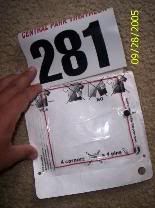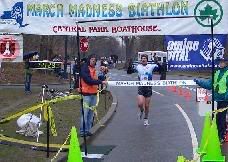Hello, my name is Stephen Carter, and I am the Director of Timing Services for TriTiming -- a timing company based in New York City and Long Island.
We are beginning our 3rd season using the disposable chip DAG system, and have had great success timing road races, biathlons, duathlons and triathlons. Last year I successfully timed over 16 races (nearly 7,000 competitors), many of which I had provided 3 splits for each competitor. I am fully capable of providing as many as 5 or more splits per competitor. I have also tested and studied the system for hundreds of hours, and have devised ways of using the system which allow me to time triathlons -- something that almost no other people are doing with the disposable Bib chip. I have formulated a novel way of implementing the handheld badger paddle -- a backup detection device -- at our split gate so as not to slow down the athletes and I have even discovered ways of maximizing the system's sensitivity by altering the primary antenna configuration.
Not withstanding a steep learning curve, the system's primary strengths are it's portability and cost relative to the other major chip systems. And of course the fact that the chips are disposable means there is no post-race chip collection; nor is there a "lost-chip" expense which is usually passed onto race directors with the other chip systems.
As most of you already know the DAG chips, like the other chip systems, are "passive" RFID tags which gain their power simply by passing through an electromagnetic field. They do not carry their own onboard power supply. In the case of the DAG chip, the chip itself is as small as a period on a printed page and is encased in a tiny quantity of epoxy resin, which itself is then covered with a small plastic shell. The rectangular wire connected to each side of the chip powers the chip. It is this wire and chip combination which are then attached to the backside of bib number via sticky backed transparent paper. As the chip and wire move through the electromagnetic field lines, a small current is "induced" within the wire and it is this small electrical pulse that activates and energizes the chip. This in turn causes the chip to emit a response through it's wire, which is then detected by the overhead detection antenna cable which is creating the EM field in the first place.
It is for this reason that the chip and wire configuration on the back of the bib are very sensitive to alterations in their shape or orientation as they pass through the detection gate. Although the chips and wires themselves are very nearly indestructible and totally waterproof, the wire can be mangled and bent by Bib's that are crumpled or folded, especially if worn on a racing belt. This then compromises the ability of the chip to gain enough electrical power to say: "Hello, I am here." and thus the primary antenna cable can potentially "miss" the chip. The handheld badger paddle not only augments and verifies the order of finish for competitors, but also corrects for any missed chips at the detection gate, thus providing a 100% detection rate.

However, this "seemingly" clumsy wire predicament is actually the primary reason why the chip can be produced for so little and thus be made disposable. Although it is true that the other chip manufactures make much tighter and smaller "induction coils" attached to their chips, these more compact designs also carry much higher production costs, and thus have not yet become "truly" disposable. But most importantly, the larger induction wire, situated on the backside of a bib number, allows for a much larger aperture of detection. By this I mean there is a much greater volume of "airspace" in which a chip can be detected within. The 2.3 meter detection gate measure 7 feet by 7 feet and the chip is detectable anywhere within that entire volume of space, and even somewhat beyond. That is quite a feet when you consider that the other major chip companies that rely on detection mats, cannot guarantee a detection if the competitor is wearing a chip on their ankle and happens to have their foot raised -- say while in mid-stride while crossing a "single" detection mat.

So by making the DAG chip with it's rectangular induction wire measuring 6.5 inches wide by 5.5 inches tall for the smallest sized bib chips, Pygmalyon, the French company which produces the DAG chip have essentially lowered the cost of production reaching disposable chip values and also increased the area of detection for their chip at the finish line. This is countered by the lack of competitor familiarity with the chip and the sensitivity of the chip to competitor mishandling.
It is imperative then that race directors give explicit and detailed directions to their competitors on how to properly use the DAG chip. New York Triathlon Club, one of our major clients, relays to their competitors very explicit instructions concerning the DAG chip both on their web site as well as during both their pre-race announcements and during number pickup. For example, bib's should not be stuffed or folded into pockets during packet pickup or at any time before or during the race. This type of competitor education is one of the simplest and most effective way of maximizing the DAG systems performance.
Best of luck to you this racing season,
Stephen Carter
Director of Timing Services
TriTimingP.O. Box 700
Mt. Marion, NY 12456




